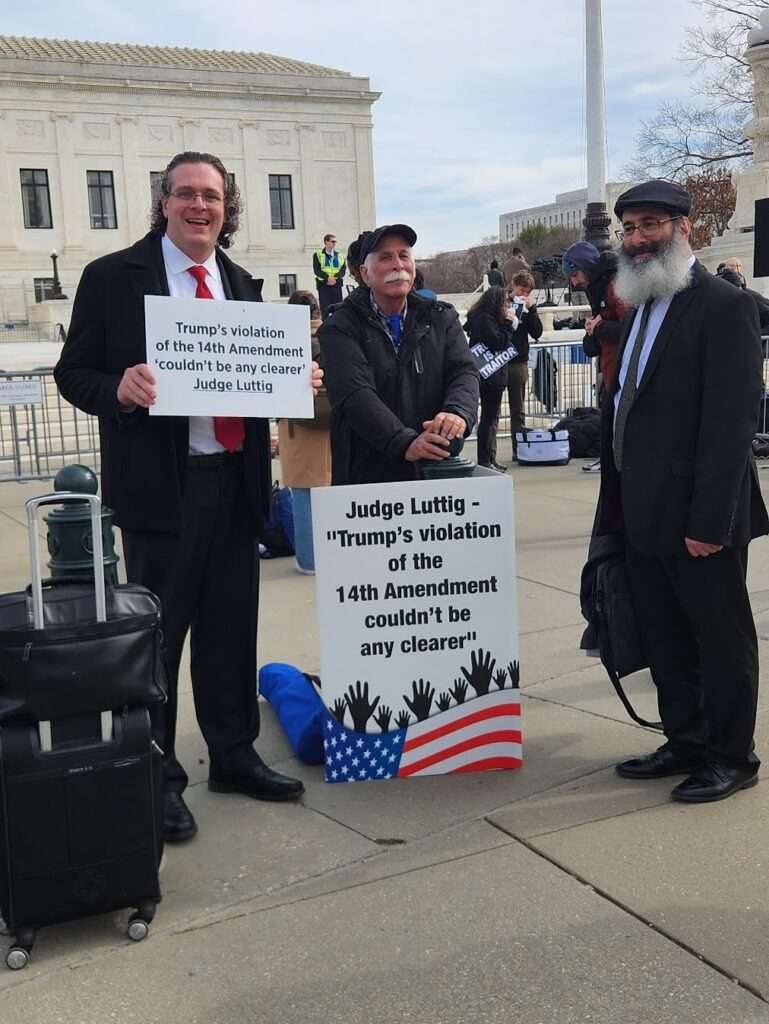The Volokh Conspiracy
Mostly law professors | Sometimes contrarian | Often libertarian | Always independent
Attending Oral Argument in Trump v. Anderson
Not exactly what I expected, but a very rewarding experience.
As regular readers will know, Seth Barrett Tillman and I have spent untold hours over the past six months, and really past three years, on Section 3. But when I walked into the Supreme Court this morning, I felt a sense of closure. All of the arguments that had to be made were made--Seth and I were up till about 10:30 pm last night, working in person (for once) on a final post. Now, the only thing left to do was sit back, relax, and hear what the Justices had to say.
The arguments did not go exactly as I expected, but it was a very rewarding experience. And I suspect that Trump will win big league. Here are my immediate reactions, made based on my hand-scrawled notes. (I may write more when the transcript is released.)
Griffin's Case, which was barely mentioned in Petitioner's opening brief, occupied a lot of the argument. Our amicus brief and article led off with Griffin's Case. We've always seen this decision as a key ground of resolving the case. Justice Kavanaugh referred to the status of Griffin's Case as "liquidated" in light of Federalist 37. Tillman and I made that point expressly in our brief at p. 5.
Although not binding, courts at all levels have seen Griffin's Case as persuasive. Griffin's Case has settled the meaning of Section 3. See Federalist No. 37 (Madison) (discussing liquidation).
If the Court adopts Griffin's Case, the sword/shield dichotomy that Tillman and I advanced will be useful. The dichotomy helps to reconcile Griffin's Case with the Case of Jefferson Davis. Our brief stated at page 9:
Finally, it is these "two distinct senses of self-execution" which "reconciled in a principled manner" Griffin's Case and Chase's decision in the Case of Jefferson Davis. See Co.Sup.Ct.¶299 (Samour, J., dissenting) (citing Blackman & Tillman, supra, at 484–505).
Jonathan Mitchell acknowledged this tension between Griffin's Case and the Case of Jefferson Davis in response to Justice Sotomayor, but did not attempt to reconcile it. Moreover, that dichotomy helps to explain the direct appeal/collateral challenge question that Justice Barrett raised. The Constitution can always be raised as a defense on direct appeal. But the Constitution can only be used as a sword with a cause of action for a collateral challenge. (Our motion for leave to participate in oral argument identified the sword/shield distinction as one where we were not on the same page as the Petitioner).
Justice Ketanji Brown Jackson was the most interested questioner on whether the presidency was an "Office under the United States." She alluded to Kurt Lash's important research. Jonathan Mitchell pushed back against that argument, fearful of what it would mean for the Foreign Emoluments Clause. That must have been Mitchell's strategy going into the Court, but he could have pivoted when he heard Jackson's repeated entreaties. At times it seemed like Jackson was Trump's lawyer and Mitchell was Colorado's lawyer. (Our motion for leave to participate in oral argument identified this as another area where we were not on the same page as the Petitioner).
Justice Gorsuch was the most interested questioner on whether the President was an "Officer of the United States."He asked about the Commissions Clause in particular. He also inquired several times about our the Speaker and the Incompatibility Clause--a point Tillman and I have advanced. He suggested that the Blackman-Tillman position may be "odd," but it is what the text says. The citations to Bostock in our brief reflected this approach. Justice Sotomayor (I am almost certain) referred to us as "some scholars." Justice Kagan interrupted Justice Jackson, and joked about that "officer stuff." The Chief smiled. I'll take it.
After we left the Court, Seth and I took what I imagine will be a Dewey-defeats-Truman photo.
Stay tuned.




Show Comments (92)